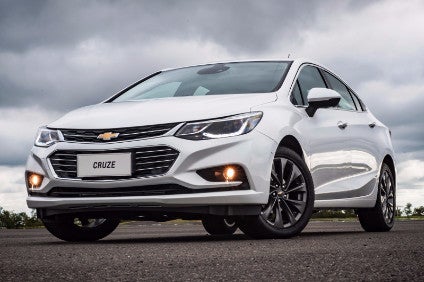
Chevrolet Brazil's second generation Cruze sedan, on sale at the end of June, is now built in Argentina, instead of locally, and is similar to the latest generation US model launched earlier in 2016.
But the hatchback version (due in the second half of this year) will be a renamed GM Europe Opel/Vauxhall Astra. This reflects GM strategy in Australia where the locally made Cruze was replaced effectively by a more upmarket Holden-badged Astra hatchback.

Discover B2B Marketing That Performs
Combine business intelligence and editorial excellence to reach engaged professionals across 36 leading media platforms.
The new Cruze sedan body for South America is a little larger (6.2cm longer, 0.9cm taller on a wheelbase stretched a miniscule 1.5cm) but rigidity is up 25%. Better yet, the car is 106kg lighter without using much expensive aluminium. Coefficient of drag (Cd) has improved 15% to 0.30. Nothing escaped wind tunnel scrutiny; even the centre, high-mounted stop light was specially reshaped to improve airflow over the car.
The battery has been moved to the rear to improve weight distribution. Re-positioning the outside mirrors improved the field of vision, especially useful for city driving.
There's just one engine to start, a turbocharged, 1.4-litre flexible-fuel unit developing 150.9bhp/5,200 rpm and 177.2lb-ft/2,200 rpm (on ethanol) with start/stop standard. The high-torque engine is well matched to the six-speed epicyclic automatic gearbox and precise steering and suspension well calibrated for local roads are among the new Cruze's excellent characteristics.
The automaker claims 0-to-100km/h acceleration in 8.5 secons and and A grade fuel economy rating under the Inmetro test procedure. The 11.2 km/l/26.3 mpg and 14 km/l/32.9 mpg city/highway (petrol), and 7.6 km/l/17.9 mpg and 9.6 km/L/22.6 mpg (ethanol) economy vaults the new Cruze into the top placings among rival medium-size saloons such as the Toyota Corolla and Honda Civic, traditional leaders in this segment.
The symmetrical, 'double cockpit' dashboard theme is carried over but with a full redesign and considerably improved materials although, surprisingly, no soft plastics are used. Chevrolet now uses French stitching (a double backstitch) for leather seats and door panels.
The second-generation multimedia system has an eight-inch capacitive screen in the centre console and a second four-inch display in the instrument cluster. Supplementing useful information like tyre pressure monitoring, the system also displays the remaining useful life of the engine oil on a percentage scale.
Second-generation OnStar 'concierge system' telematics is again standard. It is now possible to recharge smartphones using wireless induction but its Android phones only for now.
Other technology includes lane keep assist, frontal collision warning (but no autonomous braking), blind spot alert, automated parking and automatic high beam.
Prices have risen due to 10% inflation and the devaluation of Brazil's real advsersely affecting costs. There are two versions: LT priced at BRL89,990/US$26.500 and the BRL107,450/$31,600 LTZ.
Nonetheless, new standard features, previously unavailable or optional, are expected to attract buyers with higher buying power.
The perceived value difference over the outgoing 2016 model year Cruze, GM estimates, is BRL5,000/$1,470 for the LT version and up to BRL14,000/$4,117 for the LTZ.






